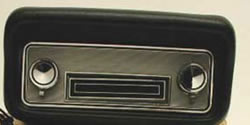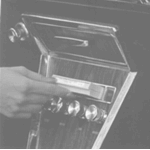The success of the Muntz cartridge on the West Coast came to the attention of Bill Lear appeared, who by this time had launched his new firm in 1963 to manufacture the Learjet corporate jet. By 1965, he announced that he had developed a cartridge with eight tracks that promised to lower the price of recorded tapes without any sacrifice in music quality.
There was a direct connection to Muntz. In 1963,he became a distributor for Muntz Electronics, mainly in order to install 4-track units aboard his Learjets. Apparently dissatisfied with the Muntz technology, he contacted two of the leading suppliers of original equipment tape heads, the Nortronics Company and Michigan Magnetics. He specified a head with much thinner “pole-pieces” and a new spacing that would allow two tracks (or one stereo program) to be played from a standard, quarter-inch tape that held a total of 8-tracks. Although only a slight departure from the Muntz player, there was enough difference for Learjet to gain key patents. During 1964, Lear’s aircraft company constructed 100 “Stereo 8” players (as they called them) for distribution to executives at the auto companies and RCA, in an effort to expand the market for the system.

An early Learjet Stereo 8 automotive player.
The early Learjet Stereo 8 player was designed with convenience in mind–and safety. The minimal knobs and controls were intended to make it quick and easy to play tapes while driving, without the driver taking his or her eyes off the road.
Just how Bill Lear managed to convince the auto executives to adopt the Stereo 8 is a little unclear. Certainly Lear brought his reputation as the successful leader of a business, and had many personal contacts in industry. In a roundabout kind of way, he already had ties to Ford. In the 1930s Lear and Paul Galvin had together built Motorola into a leading manufacturer of car radios, and Motorola was now affiliated with Ford as a supplier of automotive radios and other componenents.
Whatever the details of Lear’s selling job, the keys to the Stereo 8’s spectacular success seems to have been linked to getting the backing of both Ford and the recording industry. After getting RCA Victor to commit to the mass-production of its catalog on Learjet Stereo-8 cartridges, Ford agreed to offer the players as optional equipment on 1966 models. The response, in one Ford spokesman’s words, “was more than anyone expected.” 65,000 of the players were installed that year alone. The machines were initially manufactured Ford’s electronics supplier and the firm that had pioneered the “motor victrola” – that is, the Motorola Corporation.
Although the 8-track today is dismissed as a failure, from a contemporary standpoint it was a huge commercial success. It was the first recorded tape format to achieve a true, national mass market. Sales of Stereo 8 systems grew rapidly from the late 1960s through the mid-1970s, when recorded cassette sales rapidly rose. The earlier Muntz Stereo-Pak systems (or “4-tracks”) failed to keep up with the 8-track, although some record companies continued to issue 4-tracks into the 1970s, and players that were compatible with either format were common.
